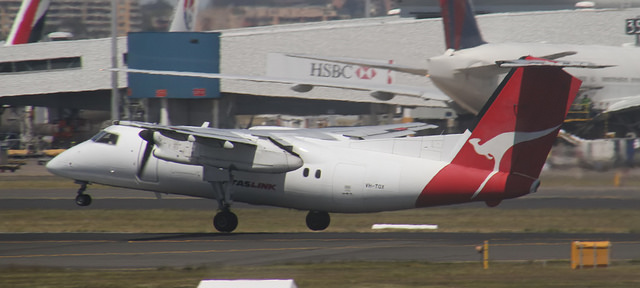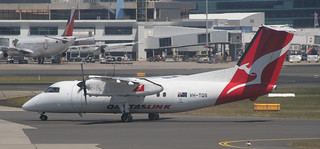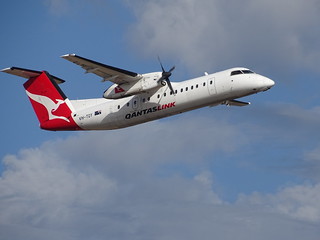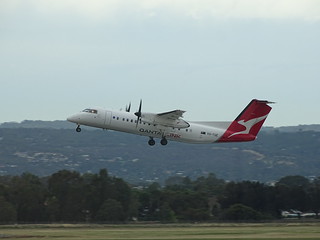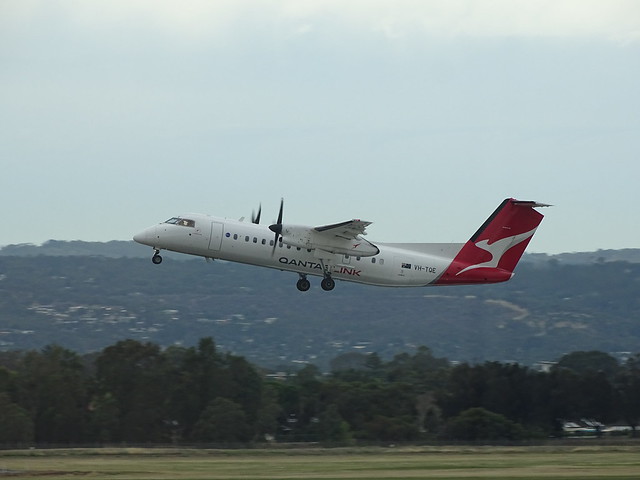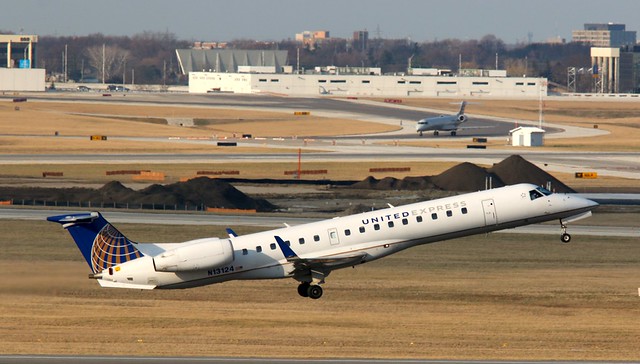Eastern Australia DH8C near Whyalla on Aug 8th 2019, inflight deployment of ditching dam
Last Update: May 14, 2020 / 13:34:49 GMT/Zulu time
Incident Facts
Date of incident
Aug 8, 2019
Classification
Report
Airline
Eastern Australia Airlines
Flight number
QF-2073
Departure
Adelaide, Australia
Destination
Whyalla, Australia
Aircraft Registration
VH-SCE
Aircraft Type
De Havilland Dash 8 (300)
ICAO Type Designator
DH8C
The aircraft remained on the ground in Whyalla for about 6 hours before performing the return flight QF-2074.
The ATSB released their final report concluding the probable causes of the incident were:
- The ditching dam cover opened in-flight, possibly due to exposure to severe icing and turbulence and/or improper engagement of the cover with the airframe.
- The deployment of the ditching dam did not increase the risk of damage to other aircraft systems or to continued safe flight.
- The ditching dam deployment occurred when flight crew had started sterile cockpit procedures but before cabin crew were required to be seated. It was appropriate that the cabin crew chose to break the sterile cockpit environment to inform flight crew of the issue.
The ATSB described the sequence of events:
Conditions for the flight were as forecast, with severe turbulence and icing conditions at lower levels. Once the aircraft reached the cruise altitude of 16,000 ft, it was clear of cloud and the crew described the conditions as calm.
At top of descent, the first officer made a public address to the cabin informing the cabin crew to ‘Prepare the cabin for landing’. This was acknowledged by the first flight attendant over the aircraft interphone. At this point, a loud repetitive banging noise started in the cabin.
The cabin crew initially suspected the sound was ice coming off the propellers and hitting the fuselage, which they had been briefed on before the flight. However, both cabin crew were confused by the volume and intensity of the noise, which did not align with their previous experience of flying in icing conditions. The cabin crew decided to break the sterile cockpit environment (see the section titled Sterile cockpit procedures) to inform the flight crew, via the interphone, of the abnormal noise in the cabin.
Up until that time, the flight crew were unaware of the issue and their only indication of a problem was being able to hear the noise when talking to the cabin crew over the interphone. There were no cockpit warnings. The captain transferred flying duties to the first officer so he could coordinate the cabin crew investigation, radio communication and decision-making tasks. The descent was halted and the aircraft held at the Whyalla RNAV holding point.
Upon further investigation by the cabin crew, they identified the sound was coming from the vicinity of the right rear emergency exit at seat row 10. Shortly after, they identified through the window a yellow object flapping on the outside of the aircraft, just below the exit. Based on this information, the flight crew concluded that the right ditching dam had possibly deployed.
The flight crew contacted their maintenance organisation and a decision was made to continue to Whyalla. The captain resumed pilot flying duties and the aircraft landed without further incident.
After landing, it was confirmed that the ditching dam at the right-hand rear emergency exit had opened in flight and been destroyed by aerodynamic forces.
The ATSB analysed:
It was reported that the cover was secure prior to the flight, but post-occurrence replacement of the ditching dam identified that it did not initially meet the required engagement tolerance into the airframe retaining channel. That raised the possibility that the occurrence cover may have appeared to be visually secure during the pre-flight inspection while also not being properly engaged.
Once the cover partially opened, aerodynamic forces drove the cover fully open and permitted the dam bag to unfurl into the airstream. The bag, cover and inflation hose then hit the fuselage repeatedly, which was the loud noise heard by the occupants of the aircraft. As a result of the deployment and given its location on the aircraft, if the device or part thereof had come loose, it was unlikely to have resulted in further damage to the aircraft.
The ditching dam opened when flight crew had initiated the sterile cockpit procedures for approach to Whyalla Airport. The cabin crew chose to break the sterile cockpit environment to inform flight crew of the issue. This had the potential to distract the flight crew from other flyingrelated tasks. However, this was appropriately balanced by the need to inform the flight crew of an abnormal situation of unknown severity. The ATSB considered that the cabin crew acted appropriately in informing the flight crew of the abnormal noise in the cabin. Management of the unexpected deployment was controlled through the use of non-normal checklists and effective resource management.
Aircraft Registration Data
Incident Facts
Date of incident
Aug 8, 2019
Classification
Report
Airline
Eastern Australia Airlines
Flight number
QF-2073
Departure
Adelaide, Australia
Destination
Whyalla, Australia
Aircraft Registration
VH-SCE
Aircraft Type
De Havilland Dash 8 (300)
ICAO Type Designator
DH8C
This article is published under license from Avherald.com. © of text by Avherald.com.
Article source
You can read 2 more free articles without a subscription.
Subscribe now and continue reading without any limits!
Read unlimited articles and receive our daily update briefing. Gain better insights into what is happening in commercial aviation safety.
Send tip
Support AeroInside by sending a small tip amount.
Related articles
Eastern Australia DH8C at Mildura on Jun 6th 2023, near collision on runway with private aircraft
An Eastern Australia de Havilland Dash 8-300 on behalf of Qantas, registration VH-TQH performing flight QF-1402 from Mildura,VI to Sydney,NS…
Eastern Australia DH8B at Lord Howe Island on Mar 29th 2024, engine shut down in flight
An Eastern Australia de Havilland Dash 8-200 on behalf of Qantas, registration VH-TQX performing flight QF-2263 from Lord Howe Island,NS to Sydney,NS…
Eastern Australia DH8B at Sydney on Nov 8th 2022, radar altimeter failure, problems with both engines, brakes fire
An Eastern Australia Airlines de Havilland Dash 8-200 on behalf of Qantas, registration VH-TQS performing flight QF-2265 from Lord Howe Island,NS to…
Eastern Australia DH8C near Mildura on Jan 30th 2022, loss of cabin pressure
An Eastern Australia de Havilland Dash 8-300 on behalf of Qantas, registration VH-TQY performing flight QF-2084 from Melbourne,VI to Mildura,VI…
Eastern Australia DH8C at Tamworth on Jan 15th 2021, incorrect takeoff data
An Eastern Australia de Havilland Dash 8-300 on behalf of Qantas, registration VH-TQE performing flight QF-7 from Tamworth,NS to Sydney,NS…
Newest articles
The GPS Problem No One Wants to Discuss in 2026
GPS is widely perceived as a solved problem. It works, it’s global, and it underpins everything from smartphones to financial systems. Yet in…
Commute ERJ145 at Washington on Jan 12th 2026, engine shut down in flight
A Commute Air Embraer ERJ-145 on behalf of United, registration N13124 performing flight UA-4295 from Washington Dulles,DC to Mobile,AL (USA) with 43…
Subscribe today
Are you researching aviation incidents? Get access to AeroInside Insights, unlimited read access and receive the daily newsletter.
Pick your plan and subscribePartner

ELITE Simulation Solutions is a leading global provider of Flight Simulation Training Devices, IFR training software as well as flight controls and related services. Find out more.
SafetyScan Pro provides streamlined access to thousands of aviation accident reports. Tailored for your safety management efforts. Book your demo today
AeroInside Blog
Popular aircraft
Airbus A320Boeing 737-800
Boeing 737-800 MAX
Popular airlines
American AirlinesUnited
Delta
Air Canada
Lufthansa
British Airways



